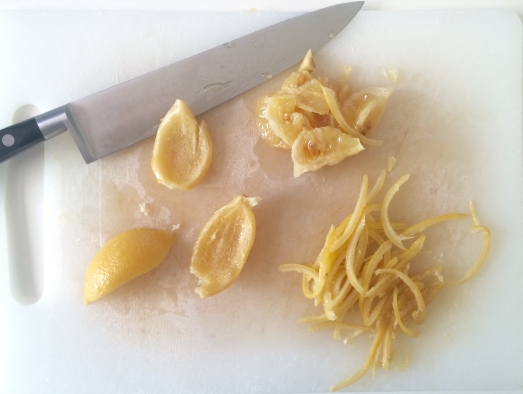
One of the flavor themes, or perhaps the central flavor theme, of Moroccan cuisine is the preserved lemon. This is one of the easiest pickles you’ll ever make, using just salt and lemon juice to preserve lemons. Preserved lemons are used as a condiment and seasoning to add brightness and depth of flavor– what I like to think of as citrusy umami.
If you live in California like I do, you’ll be hard pressed not to find lemon trees overburdened with the sunny citrus all year round. I don’t have a lemon tree myself, but my neighbor, Jack, does, and he is more than happy to share his lemons, which would otherwise go to waste.
Three months ago, after I started my culinary externship in the kitchen at Michelin-starred Mourad, in San Francisco, I looked over at Jack’s tree and decided it was time to preserve some lemons for my own use. A quick phone call later, and I had a grocery bag full of organic, very local lemons.
The process is simple, whether you have a neighbor’s generous donation of lemons, or if you buy them. Try to get organic, because it is the peel that you will be eating. Either way, scrub vigorously with a brush and then dry your lemons. Get some wide-mouthed Mason jars ready.
Next, cut your lemon into quarters, but not all the way, so that the quarters are still attached and hold together.
Then get a big box of Kosher salt and cram as much salt as you can into the exposed/cut areas of each lemon (up to a few tablespoons per lemon). As you finish each lemon, place it into the Mason jar, cramming as many lemons as you can into the jar. When you can’t it any more, cut an equal number of lemons and squeeze their juice over the salted lemons until they are completely submerged. This is the key to make sure that they are preserved, rather than rotting. Now you can seal the jar, and keep in a dark cabinet at room temperature. Mark the date, because you’ll forget when you made them. For the first week, shake the sealed jars once daily to redistribute the salt. Now is the hard part: wait a minimum of one month but if you can, perhaps 3 to 6 months for best flavor.

This is what they look like when they are done. The rind will have softened, possibly changed color slightly. With very rare exceptions, you will only be using the rind (not the pulp) of your lemons, and sometimes the brine.

To use, take a piece of lemon, rinse it to remove excess saltiness, and remove the pulp with a knife or spoon. Scrape off as much of the pith (the white part) as you can because even preserved, it will be bitter.
Recipe Ideas with Preserved Lemon
- julienne the preserved peel and use it to garnish a bowl of warmed olives
- add preserved lemon peel to your tagines
- use preserved lemon make a salsa verde of it with lots of freshly chopped parsley and olive oil
- get fancy as they do at Mourad and make preserved lemon purée: purée preserved lemon peel in a Vitamix or food processor with a bit of water and olive oil for a condiment. It will be salty, of course, so remember that a little bit goes a long way.
- whisk the brine or preserved lemon puree into dressings or sauces, any place you might use salt + lemon juice

Once you have opened your jar of preserved lemons, top it off with a small amount of olive oil to prevent oxidation, and store either at room temperature or in the refrigerator. I haven’t made it this far yet, but if you want to keep them longer, for up to a year, Chef Mourad recommends draining them and keeping only the rind, completely submerging them in a jar of olive oil, and keeping them refrigerated.
Shokran (thank you!) for coming by! Have you made preserved lemons? What are some of the recipes you’ve used them in? Suggestions very welcome in the comments! And come back soon– more to come on the Morocco trip and the food I ate there.

Pingback: The Best Meal in Morocco– Couscous in the High Atlas, with Recipe for Chicken Tagine | spicebox travels
Pingback: Savory Moroccan Yogurt | spicebox travels
Reblogged this on spicebox travels.